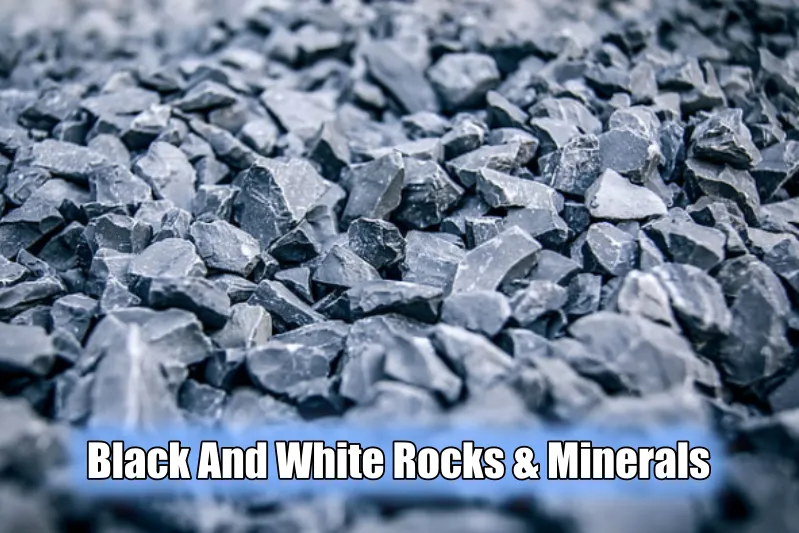During our childhood days, we often found joy in playing with stones as we strolled down the road, didn’t we? You might have even pondered about how these stones came to be, and as time went on, you likely discovered the fascinating process of their formation.
Today, however, our focus won’t be on the formation of just any rocks. Here, we’ll explore the fascinating world of black-and-white rocks and minerals that have taken shape over an extended period.
Join me as we take a closer look at these unique formations together.
13 Marvelous Black and White Rocks:
1. Diorite
Diorite is an intrusive igneous rock formed by the slow cooling of magma underground. Moreover, it has a moderate silica content and low alkali metals and is intermediate in composition between low-silica (mafic) gabbro and high-silica (felsic) granite.
Found in mountain-building belts on continent margins, it shares the same composition as andesite, a fine-grained volcanic rock.
Also, its chemical composition is intermediate between mafic gabbro and felsic granite, with the plagioclase species being richer in sodium and poorer in calcium.
2. Felsite
Next is Felsite, a light-colored volcanic rock with a fine-grained matrix of felsic materials, including quartz, sodium, and potassium feldspar. It is typically extrusive, formed by the compaction of fine volcanic ash.
The rock’s fine texture and felsic components allow for good knapped pieces, producing conchoidal fractures. Mostly, it is used to make stone tools.
It may also contain decaying manganese oxides like pyrolusite and iron oxides like limonite, giving rock chunk surfaces multicolored or arborescent-patterned textures.
3. Gabbro
Gabbro is a coarse-grained, mafic intrusive igneous rock formed from the slow cooling of magnesium-rich and iron-rich magma into a holocrystalline mass deep beneath the Earth’s surface.
It is chemically equivalent to rapid-cooling, fine-grained basalt. Gabbro is found in much of the Earth’s oceanic crust and plutons associated with continental volcanism.
4. Granodiorite
Granodiorite is an intrusive igneous rock with a phaneritic texture, visible to the naked eye. It forms slowly below the earth’s surface and is similar to granite and diorite but has more plagioclase feldspar than orthoclase feldspar.
According to the QAPF diagram, granodiorite has over 20% quartz by volume, and 65% to 90% of the feldspar is plagioclase. The texture and appearance of granodiorite are crucial for geologists and researchers to identify and classify the rock.
Granodiorite is medium- to coarse-grained, with individual mineral grains visible to the naked eye. It often appears as a speckled or salt-and-pepper-like rock due to interlocking crystals of different mineral colors.
The coloration of granodiorite can range from light gray to light brown or pinkish-gray, depending on factors like plagioclase feldspar, quartz, and mafic minerals like biotite or hornblende.
5. Pegmatite
Pegmatite crystal texture within pegmatitic rock can be extreme in size and perfection. Feldspar within a pegmatite can display exaggerated and perfect twinning, exsolution lamellae, and macroscale graphic texture when affected by hydrous crystallization.
Perthite feldspar within a pegmatite often shows a gigantic perthitic texture visible to the naked eye.
Pegmatites can form from waters that separate from magma in the late stages of crystallization, often occurring in small pockets along the margins of a batholith or in fractures that develop on the margins of the batholith.
Large intrusions of feldspathoid syenites are commonly accompanied by pegmatites, veins, lenses, and pods of coarse crystalline material.
6. Amphibolite
Amphibolite is a metamorphic rock, primarily composed of mineral amphibole and plagioclase feldspar, found around metamorphic and igneous rock intrusions.
It has significant components found in both volcanic and plutonic rocks, ranging from granitic to gabbroic. Formed due to heating pre-existing rocks, resulting in mineralogical and physical changes. They erode over time through wind, sea, glacier, and chemical erosion.
The highest-quality amphibolite is quarried for specific architectural design purposes, with smooth, variable, and shiny features. It is harder than limestone and heavier than granite, making it suitable for highway and railroad construction.
Amphibolite has various antiquity uses, including artifacts, sculptures, and small figurines. It is also used commercially in cemetery markers, commemorative tablets, and artwork.
They form asbestiform aggregates, radiating sprays, and long prismatic crystals. They can crystallize in igneous and metamorphic rocks due to the wide range of chemical substitutions allowed in their crystal structure. British mineralogist Bernard E. Leake identified five major groups of amphibole, leading to 76 chemically defined compositions.
7. Andesite
Andesite is an extrusive igneous rock, primarily composed of plagioclase feldspar and mafic minerals like hornblende. It has an aphanitic texture, making its interlocking crystals invisible to the naked eye.
Andesite is usually light or dark gray and is often porphyritic. It is intermediate in composition between basalt and rhyolite and can be difficult to distinguish from closely related rocks.
Andesite has a fine-grained texture with small, interlocking crystals of white to off-white plagioclase feldspar and darker, mafic minerals like hornblende. It is usually light to dark gray and often contains larger crystals called phenocrysts.
Variations in andesite appearance can be due to subtle variations in mineralogy, the gas content of the lava, and cooling conditions.
8. Agate
Another black and white rock and mineral family member is Agate. It is a banded variety of chalcedony found in volcanic and metamorphic rocks. It was used in ancient Greece for ornamental jewelry and seal stones.
Agate minerals form on or within pre-existing rocks, making it difficult to determine their formation time.
The priming layer is the first layer, and variations in layers result in bands of chalcedony and crystalline quartz. Hollow agates can also form due to the deposition of liquid-rich silica not penetrating deep enough.
9. Syenite
Syenite is a rare, light-colored, and coarse-grained igneous rock with a distinctive composition and appearance. It is primarily composed of feldspar, typically orthoclase feldspar, and may contain smaller amounts of other minerals like hornblende, mica, or amphibole.
Syenite’s appearance is often pinkish due to its high alkali content with little quartz. It lacks features like layering, banding, or fossils. Syenite’s appearance can vary greatly due to the mineralogy of each type and subtle differences in crystal sizes.
Other common accessory minerals include apatite, titanite, zircon, and other opaques. Most syenites are either peralkaline with high alkali elements relative to aluminum or peraluminous with a higher concentration of aluminum.
10. Augite
Augite is a rock-forming mineral found in mafic and intermediate igneous rocks like basalt, gabbro, andesite, and diorite. It is typically green, black, or brown in color and exhibits two distinct cleavage directions intersecting at slightly less than 90 degrees.
Augite has a Mohs hardness of 5.5 to 6 and a specific gravity of 3.2 to 3.6, which is higher than most other minerals in its rocks. Its cleavage directions intersect at slightly less than 90 degrees, making it difficult to observe.
11. Biotite
Coming to the next black-and-white rock and mineral member is Biotite. It is a group of black mica minerals found in igneous and metamorphic rocks, including annite, phlogopite, siderophyllite, fluorophlogopite, fluorannite, and eastonite. These micas have similar physical properties but differ in chemical composition.
Biotite forms under metamorphic conditions when argillaceous rocks are exposed to heat and pressure, forming schist and gneiss. It is not resistant to weathering and can sometimes be found in sediments and sandstones.
Biotite is easy to identify, with perfect cleavage and a vitreous luster on its face. When separated into thin sheets, biotite is flexible but breaks upon severe bending.
When exposed to light, the sheets are transparent to translucent with a brown, gray, or greenish color. Experienced observers can sometimes recognize phlogopite by its brown color.
12. Chromite
Chromite is an oxide mineral made up of chromium, iron, and oxygen (FeCr2O4). It is dark gray to black, with a metallic to submetallic luster and high specific gravity.
It is the only economic ore of chromium, essential for various metal, chemical, and manufactured products. Identifying chromite is challenging due to its color, specific gravity, luster, and characteristic brown streak.
It is most important to consider its association with ultrabasic igneous rocks and metamorphic rocks like serpentinite. Chromite is sometimes slightly magnetic, which can confuse it with magnetite.
13. Hornblende
Hornblende is a term used to describe a group of dark-colored amphibole minerals found in various types of igneous and metamorphic rocks. These minerals, which vary in chemical composition but share similar physical properties, are double-chain inosilicates.
The group is easily identifiable by its dark color and excellent cleavage angles, which intersect at 124 and 56 degrees. This distinguishes it from augite and other pyroxene minerals, which have a short blocky habit and cleavage angles intersecting at about 90 degrees.
The presence of cleavage can also distinguish it from black tourmaline, which often occurs in the same rocks. Identifying individual members of the Hornblende group is challenging unless skilled in optical mineralogy, x-ray diffraction, or elemental analysis.
Conclusion:
As we conclude our exploration of these remarkable black and white rocks, we’ve found a world shaped by slow and steady geological processes.
From the mysterious depths where diorite quietly forms to the intricate patterns of agate in the volcanic embrace, each rock tells a story of its formation.
Whether it’s the metamorphic amphibolite rock or the metallic chromite rock. If you want to know more about these rocks and grasp more knowledge about nature then join us on HowItSee.
Reference:
- Geology
- Geology science
- Wikipedia
- Science direct
Also Read:

As a content writer, I like to write about different niches. I have a curiosity about nature and animals. And like to learn about them. Through my writing, I like to share my experience and knowledge with you. I hope you are enjoying it too.
